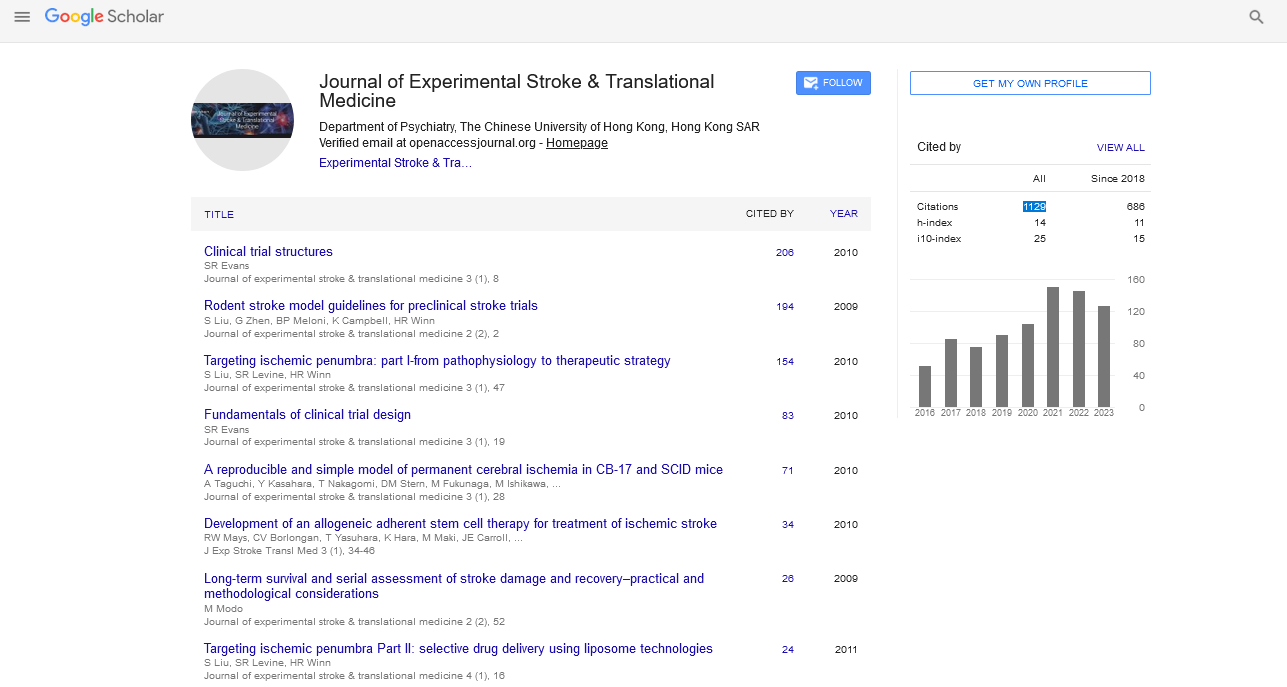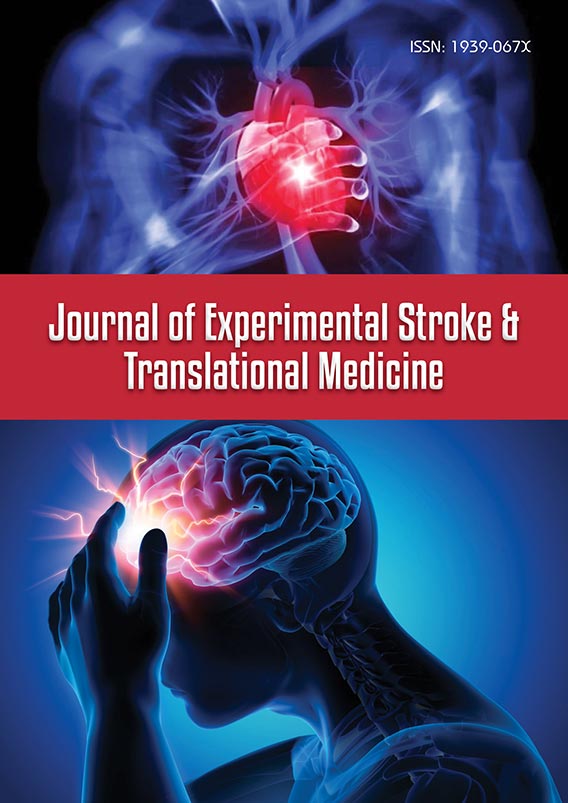Perspective - Journal of Experimental Stroke & Translational Medicine (2025) Volume 17, Issue 1
Navigating Time: The Therapeutic Window for Acute Ischemic Stroke
Bin Deg*
Department of Cardiology, Nanjing Medical University, Nanjing, China
- *Corresponding Author:
- Bin Deg
Department of Cardiology, Nanjing Medical University, Nanjing, China
E-mail: xajb@126.com
Received: 27-Nov-2023, Manuscript No. JESTM-23-121190; Editor assigned: 29-Nov-2023, PreQC No. JESTM-23-121190 (PQ); Reviewed: 13-Dec-2023, QC No. JESTM-23-121190; Revised: 14-Feb-2025, Manuscript No. JESTM-23-121190 (R); Published: 21-Feb-2025, DOI: 10.37532/JESTM.2025.17(1).299-300
Introduction
In the intricate dance between time and intervention, acute ischemic stroke poses a formidable challenge that demands precision and swiftness. The concept of the therapeutic window, a critical timeframe within which interventions can yield optimal results, is central to reshaping outcomes for stroke patients. This article explores the nuances of the therapeutic window for acute ischemic stroke, shedding light on the importance of time in the quest for effective and timely interventions.
Description
Understanding acute ischemic stroke
Acute ischemic stroke occurs when a blood clot obstructs a blood vessel supplying the brain, leading to a sudden disruption of blood flow. The resulting oxygen deprivation and nutrient deficiency can have rapid and severe consequences, making timely intervention paramount. The therapeutic window, often referred to as the golden hour, represents the limited time during which medical interventions can potentially mitigate damage and improve the chances of recovery.
The golden hour: Early recognition and response
The first link in the chain of stroke care is the early recognition of symptoms. Public awareness campaigns emphasize the acronym FAST (Face drooping, Arm weakness, Speech difficulty, Time to call emergency services) as a mnemonic for recognizing signs of stroke. Rapid identification of these symptoms triggers an immediate response, with emergency medical services being alerted to expedite the transfer of the patient to a stroke-ready facility.
Time is brain: The urgency of reperfusion therapies.
The therapeutic window for acute ischemic stroke is underscored by the mantra “time is brain.” The longer the delay in restoring blood flow to the affected region, the greater the risk of irreversible damage. Reperfusion therapies, such as intravenous tissue Plasminogen Activator (IV tPA) and mechanical thrombectomy, aim to dissolve or remove the clot causing the obstruction. These interventions are most effective when administered within the golden hours after symptom onset.
Intravenous tPA: The power of clot dissolution
Intravenous tPA, administered within the first few hours after symptom onset, is a cornerstone of acute ischemic stroke treatment. This clotbusting medication works by dissolving the obstructive clot, restoring blood flow to the brain. However, the therapeutic window for IV tPA is limited, generally up to 4.5 hours after symptom onset. Beyond this timeframe, the risk of complications, such as hemorrhagic transformation, outweighs the potential benefits.
Mechanical thrombectomy: Extending the window
The advent of mechanical thrombectomy has extended the therapeutic window for certain stroke patients, particularly those with large vessel occlusions. This procedure involves the insertion of a catheter to physically remove the clot, offering a more direct and efficient approach. The extended window for mechanical thrombectomy, often up to 24 hours or more from symptom onset, has been a game-changer, allowing for intervention in patients who might have missed the opportunity for IV tPA.
Wake-up strokes: Challenges and opportunities
The concept of wake-up strokes, where symptoms are discovered upon waking, adds complexity to the therapeutic window. Determining the time of symptom onset becomes challenging, impacting the eligibility for time-sensitive interventions. Advanced imaging techniques, such as MRI with diffusion-weighted imaging, are being explored to identify wake-up stroke patients who may still benefit from thrombolytic therapies.
Beyond reperfusion: Neuroprotective strategies
While reperfusion therapies are crucial, the therapeutic window also encompasses neuroprotective strategies that aim to minimize secondary damage. These approaches, including maintaining optimal blood pressure, managing glucose levels, and preventing hyperthermia, contribute to a holistic and supportive environment for the recovering brain.
Challenges and opportunities in telestroke
Geographic barriers and limited access to stroke expertise in certain areas pose challenges to timely intervention. Telestroke services, leveraging technology to connect remote healthcare providers with stroke specialists, have emerged as a promising solution. These services enable rapid consultation, decision-making, and guidance for interventions, narrowing the geographical gap in stroke care.
The future: Personalized medicine and beyond
As research progresses, the future of acute ischemic stroke care holds the promise of personalized medicine and further refinement of the therapeutic window. Biomarkers, advanced imaging technologies, and predictive modeling may enhance our ability to tailor interventions based on individual patient characteristics, optimizing the delicate balance between risks and benefits within the therapeutic window.
Conclusion
The therapeutic window for acute ischemic stroke is a critical concept that underscores the urgency and precision required in stroke care. As we unravel the complexities of stroke pathology and advance our understanding of individualized responses to treatment, the therapeutic window becomes not only a race against time but a canvas upon which personalized and targeted interventions can be painted. The ongoing pursuit of efficiency, accessibility, and innovation in stroke care ensures that the symphony of time and intervention continues to evolve, offering hope and improved outcomes for those navigating the challenging landscape of acute ischemic stroke.

